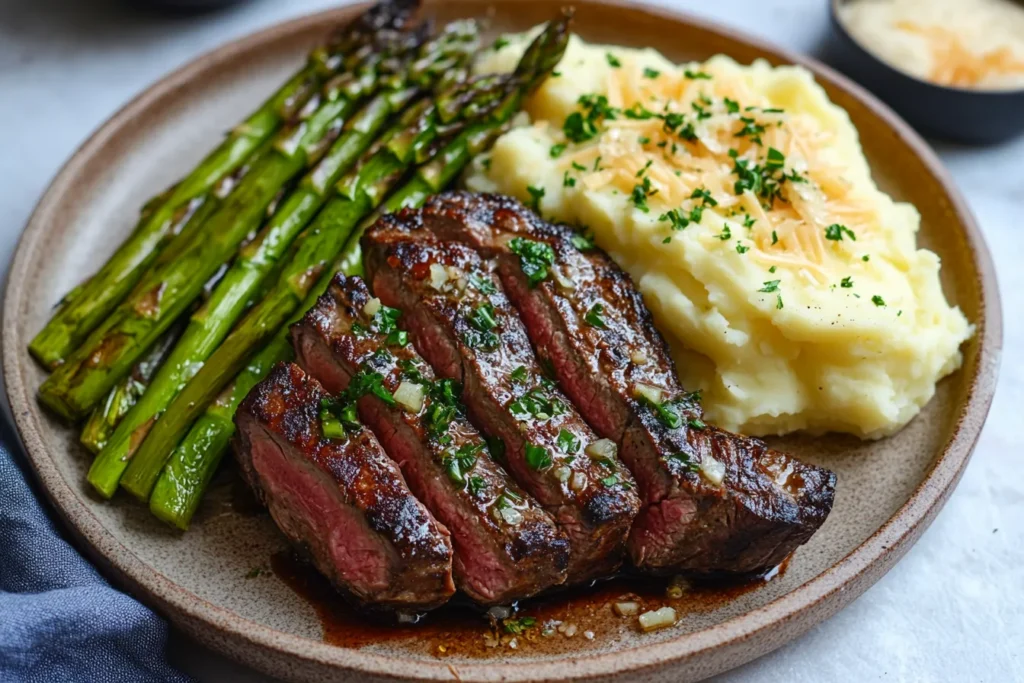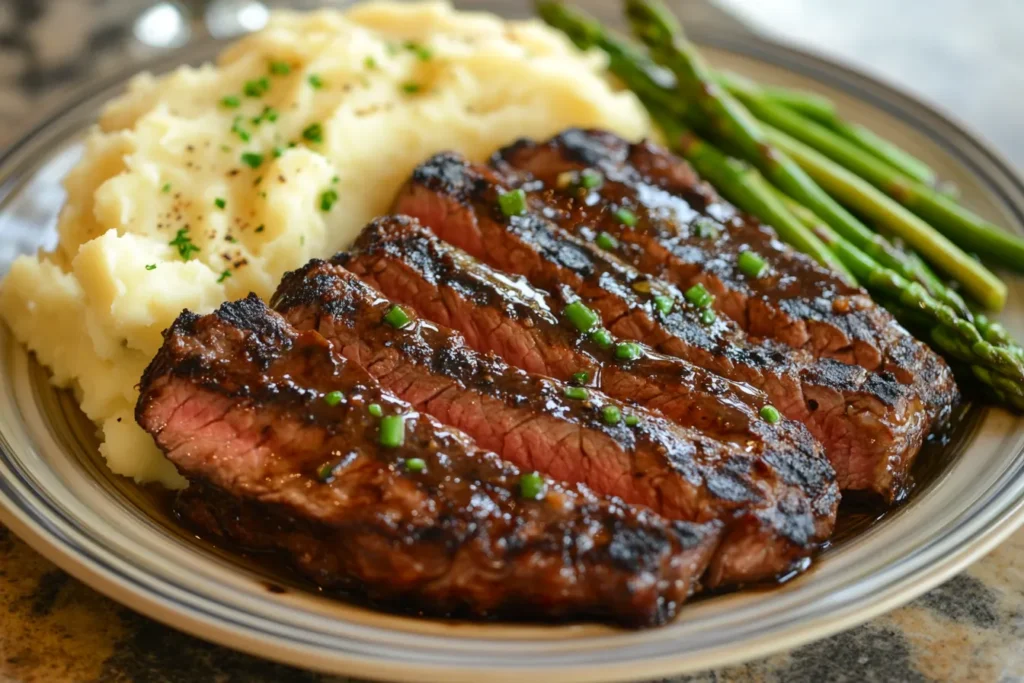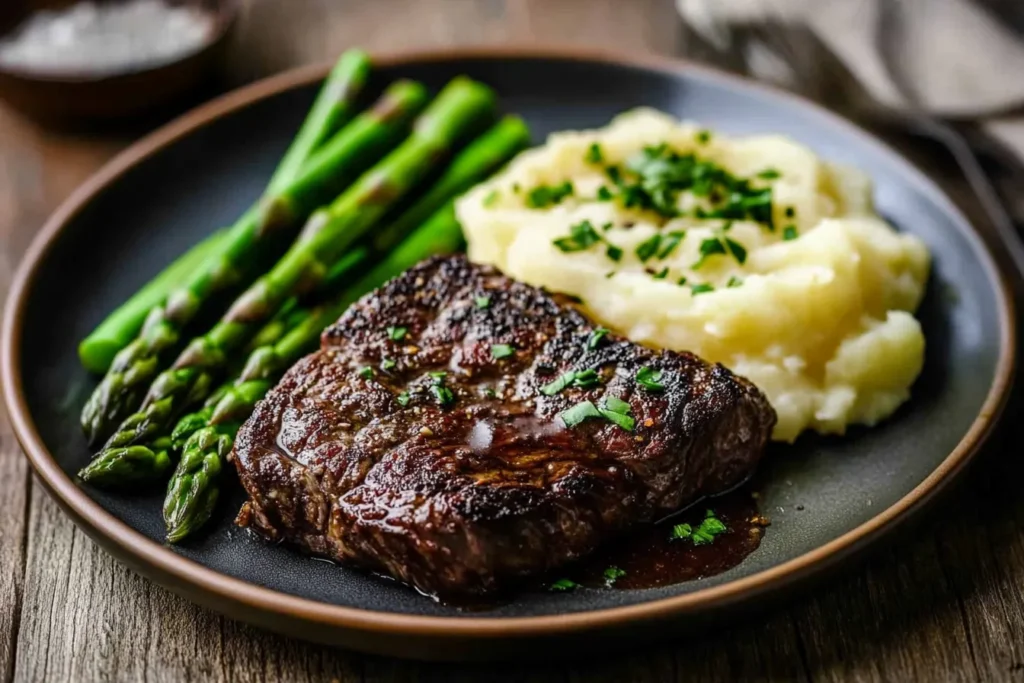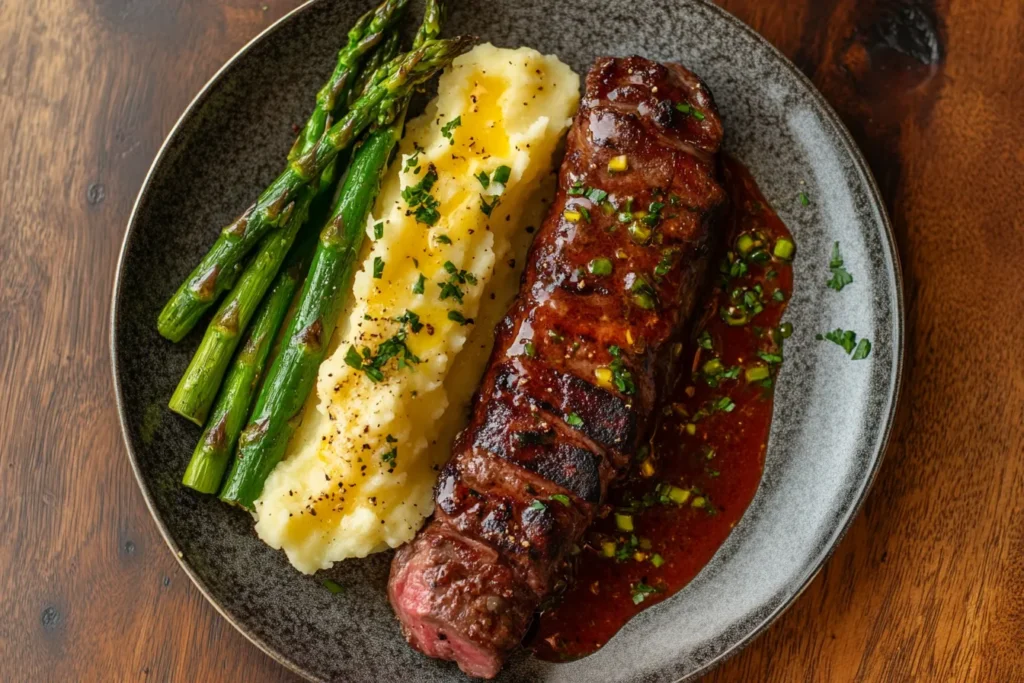Have you ever wondered why some marinades take your dishes to the next level while others fall flat? The secret lies in balancing the right ingredients. If you’ve ever been stuck staring at your pantry, unsure how to create a marinade that’s flavorful, tenderizing, and just plain delicious, you’re not alone. The good news? It’s much simpler than it seems! A great marinade only needs three main ingredients to work its magic. I’ve been there too, overthinking every little detail when all I needed was to stick to the basics. Once I figured out this simple formula, marinades became my go-to for effortless, flavorful meals. Let’s break it down so you can master the art of marinating in no time!
List Of Contents
Introduction to Gordon Ramsay’s Steak Marinade
When it comes to cooking steak, few names command as much respect as Gordon Ramsay. Renowned for his bold flavors and straightforward approach, Ramsay’s techniques consistently deliver restaurant-quality results at home. One of his standout methods involves using a perfectly balanced steak marinade to enhance flavor and texture. Check out more recipes here.
Importance of a Good Marinade for Steak
Marinating steak isn’t just about adding flavor; it’s about transforming the meat. A good marinade can penetrate deep into the steak, infusing it with a rich taste while tenderizing it. Ramsay emphasizes the importance of combining high-quality ingredients with proper timing to achieve the perfect steak.
Gordon Ramsay’s Culinary Philosophy on Marinating Meats
Ramsay’s approach is grounded in simplicity and precision. He believes in letting the natural flavors shine, and his marinade recipes reflect that philosophy. Using the right balance of acids, aromatics, and oils, he creates a foundation that complements, rather than overpowers, the steak.
Why Marinade Matters

Enhancing Flavors and Textures
A marinade works by soaking the steak in a mixture that includes acids, enzymes, and seasonings, which break down tough fibers in the meat. This process enhances tenderness while infusing every bite with mouthwatering flavor. Additionally, the right marinade can create a beautiful crust when the steak is cooked.
Tenderizing the Meat
The acids in a marinade—like lemon juice or vinegar—play a vital role in softening the muscle fibers. Ramsay’s steak marinade is a perfect example of how acids, when used in moderation, can make even the toughest cuts of meat juicy and tender.
Gordon Ramsay’s Approach to Steak Cooking
Focus on Simplicity and Bold Flavors
Ramsay’s cooking philosophy revolves around highlighting natural flavors. He combines a few powerful ingredients to create marinades that are both versatile and impactful. For example, his steak marinade features fresh herbs, garlic, and olive oil, which blend harmoniously to elevate any cut of steak.
Key Ingredients in Gordon Ramsay’s Marinade
- Herbs and Spices: Fresh rosemary and thyme provide an earthy aroma.
- Acids: Lemon juice and Worcestershire sauce balance the richness of the meat.
- Oils: Olive oil acts as a carrier for flavors and keeps the steak moist.
- Aromatics: Garlic and shallots infuse the steak with depth and complexity.
Step-by-Step Overview of the Recipe
If you’re eager to recreate Ramsay’s magic at home, the process is surprisingly straightforward. Here’s a quick look at what you’ll need to do:
- Combine all the marinade ingredients in a bowl.
- Coat the steak thoroughly with the mixture.
- Allow the steak to marinate for at least 30 minutes, or longer for tougher cuts.
For a full breakdown of the science behind each step, keep reading!
The Science Behind Marinades
Marinades work on both a chemical and physical level. Acids, such as lemon juice, denature the proteins in the meat, which makes it more tender. Meanwhile, enzymes in ingredients like Worcestershire sauce help break down connective tissue. Understanding these processes helps you customize the marinade for your preferred steak texture.
Common Steak Cuts to Use with This Marinade
Not all steaks are created equal, and certain cuts pair better with Ramsay’s marinade. Here are some recommendations:
- Ribeye: Known for its marbling, ribeye absorbs the marinade beautifully, resulting in a juicy and flavorful steak.
- Sirloin: This leaner cut benefits from the tenderizing properties of the marinade.
- Filet Mignon: While naturally tender, a marinade adds a layer of flavor that enhances this premium cut.
Essential Kitchen Tools for Preparing Marinades

To ensure you execute the recipe perfectly, make sure to have these tools on hand:
- Mixing Bowls: For combining ingredients.
- Sealable Bags: Ideal for marinating steak without leaks.
- Whisk: Helps emulsify the marinade for a smooth texture.
Selecting the Best Steak for Ramsay’s Marinade
The quality of the steak is as crucial as the marinade itself. Ramsay recommends opting for grass-fed beef whenever possible, as it offers superior flavor and texture. Here’s how to choose the best steak:
- Look for bright red color with a fine texture.
- Ensure the cut has minimal sinew for easier cooking.
- For more economical options, select cuts with consistent marbling.
Frequently Asked Questions About Marinades
How long should a steak be marinated?
The marinating time depends on the cut of the steak. For tender cuts like ribeye, 30 minutes is sufficient. Tougher cuts, such as flank steak, benefit from a marinating time of up to 8 hours.
Can this marinade be reused?
No, it’s not safe to reuse marinade that has come into contact with raw meat. However, you can reserve a portion of the marinade before adding the steak to use as a sauce later.
The Ingredients List for Gordon Ramsay’s Steak Marinade
Crafting the perfect marinade begins with selecting the right ingredients. Each component in Gordon Ramsay’s steak marinade plays a critical role, from enhancing flavor to improving texture. Below, we’ll break down the essential elements and how they work together to elevate your steak.
Fresh Herbs: The Heart of the Marinade
Fresh herbs like rosemary, thyme, and parsley are essential in Gordon Ramsay’s recipe. Their earthy and aromatic qualities infuse the steak with a robust flavor profile. Here’s why each herb matters:
- Rosemary: Adds a slightly piney, savory note that complements rich cuts like ribeye.
- Thyme: Enhances the natural meaty flavors without overpowering.
- Parsley: Provides a touch of freshness to balance the marinade’s richness.
Pro Tip: Always use fresh herbs for the best results. Dried herbs can work in a pinch but won’t deliver the same intensity.
Aromatics: The Flavor Enhancers
Aromatics such as garlic, shallots, and onions are critical for creating depth. These ingredients release oils when crushed or chopped, blending harmoniously with other components.
- Garlic: Adds a bold, pungent kick that pairs beautifully with steak.
- Shallots: Offer a sweeter, subtler onion flavor for a more nuanced marinade.
- Onions: Provide a touch of natural sweetness that caramelizes during cooking.
Why Aromatics Matter
As the marinade penetrates the steak, the aromatics cling to the surface, ensuring every bite bursts with flavor. For an added twist, lightly sauté the garlic before adding it to the marinade to mellow its intensity.
Acids: The Tenderizers
Acids are one of the most important elements in any marinade because they help tenderize the meat. Ramsay often uses:
- Lemon Juice: A fresh and tangy choice that brightens the overall flavor.
- Balsamic Vinegar: Adds a sweet and slightly tart note, perfect for steak.
- Worcestershire Sauce: A Ramsay favorite, this ingredient combines tanginess with umami, creating a rich and savory base.
Key Tip: Be cautious with the amount of acid. Too much can break down the meat’s proteins excessively, leading to a mushy texture.
Oils and Fats: The Moisturizers

The oil in the marinade doesn’t just help distribute the flavors—it also keeps the steak moist. Ramsay typically opts for olive oil, known for its smooth texture and mild fruitiness. However, other options include:
- Avocado Oil: A neutral option with a high smoke point, ideal for grilling.
- Canola Oil: A budget-friendly alternative that works well for marinating.
Why Fats Matter
Fats act as carriers for the herbs and spices, ensuring even coating and deeper penetration of flavors. Additionally, they create a protective barrier during cooking, helping to lock in moisture.
Seasonings and Spices: The Flavor Boosters
No marinade is complete without the right seasonings. Ramsay’s recipe calls for a mix of salt, black pepper, and sometimes a touch of heat. Here are his go-to seasonings:
- Salt: Enhances the natural flavors of the meat.
- Black Pepper: Adds a subtle heat and earthy aroma.
- Chili Flakes or Paprika: For those who prefer a spicy kick.
Pro Tip: Use freshly ground pepper for a more vibrant flavor.
Optional Add-Ons for a Unique Twist
While Ramsay’s recipe is classic, you can experiment with add-ons to suit your taste preferences:
- Soy Sauce: Adds a rich umami flavor.
- Mustard: Provides tanginess and complexity.
- Honey: adds a hint of sweetness, creating balance in the marinade.
These ingredients can be incorporated to create a signature marinade that reflects your personal style.
Substitutions for Dietary Restrictions
If you’re catering to specific dietary needs, there are plenty of substitutions available:
- For Gluten-Free Diets: Replace Worcestershire sauce with tamari or coconut aminos.
- For Vegan Options: Use a plant-based steak alternative and swap honey for agave nectar.
Ramsay’s marinade is adaptable, making it easy to accommodate any restrictions without compromising on flavor.
Sourcing Fresh Ingredients
Fresh ingredients make all the difference. When shopping, consider:
- Farmers’ Markets: These offer the freshest herbs and produce.
- Grocery Stores: Opt for organic herbs and oils when possible.
Always check the labels for oils and acids to ensure you’re getting the highest quality products.
Budget-Friendly Ingredients for the Marinade
You don’t have to break the bank to replicate Ramsay’s recipe. Here are a few cost-saving tips:
- Use Dried Herbs: While fresh herbs are ideal, dried versions can be a more affordable option.
- Buy in Bulk: Items like olive oil and black pepper are cheaper when purchased in larger quantities.
- Seasonal Shopping: Purchase ingredients when they’re in season for better prices and quality.
Preparing the Ingredients for Best Results
The way you prepare the ingredients significantly impacts the marinade’s effectiveness. Follow these tips for best results:
- Chopping Herbs: Roughly chop herbs to release their oils without overprocessing.
- Mixing Acids and Oils: Whisk these components thoroughly to ensure even distribution.
- Storing: Use a sealable bag or airtight container to prevent the marinade from losing its potency.
Frequently Asked Questions About Ingredients

Is it possible to substitute fresh herbs with frozen ones?
Fresh herbs are preferred for their vibrant flavors, but frozen herbs can work if that’s what you have on hand.
What’s the best alternative to olive oil?
Avocado oil or grapeseed oil are excellent substitutes with neutral flavors and high smoke points.
Should I pre-mix the marinade or layer it on the steak directly?
Pre-mixing ensures the flavors are evenly distributed, so it’s the better method.
Step-by-Step Instructions for Gordon Ramsay’s Steak Marinade
Cooking the perfect Gordon Ramsay’s Steak Marinade steak begins with mastering the marinade. Gordon Ramsay’s method is simple yet impactful, transforming your steak into a flavorful and tender masterpiece. Follow these detailed steps to bring his famous marinade to life.
Combining Ingredients in a Bowl
- Collect all the ingredients, making sure they are fresh and of excellent quality.
- In a medium-sized mixing bowl, whisk together olive oil, lemon juice, Worcestershire sauce, and balsamic vinegar.
- Add minced garlic, chopped herbs (rosemary and thyme), and a pinch of salt and pepper.
- Whisk until the mixture is emulsified and all components are well-blended.
Pro Tip: Taste the marinade at this stage. Adjust seasoning or acidity as needed before applying it to the steak.
Marinating the Steak Properly
- Place your steak in a sealable plastic bag or a shallow dish.
- Pour the marinade over the steak, ensuring it coats both sides evenly.
- Gently massage the marinade into the steak for better penetration.
Ideal Marinating Time:
- Tender cuts (ribeye, sirloin): 30 minutes to 2 hours.
- Tougher cuts (flank, skirt steak): Up to 8 hours.
Avoid over-marinating, as this can result in mushy texture due to excessive acid breakdown.
Tips for Timing and Refrigeration
- Make sure to marinate your steak in the refrigerator to avoid bacterial growth.
- Allow the steak to sit at room temperature for about 30 minutes before cooking to promote even cooking..
Key Tip: Use a timer or set a reminder to avoid forgetting your steak in the marinade.
Handling and Storing the Marinade Safely
- Avoid Cross-Contamination: Never reuse marinade that has touched raw meat unless boiled first.
- Storage: Refrigerate any leftover marinade for up to 3 days if it hasn’t been in contact with the steak.
Cooking the Marinated Steak
Once your steak has absorbed all the flavors, it’s time to cook it. Here are Ramsay’s top methods:
1. Grilling
- Preheat the grill to high heat.
- Cook the steak by searing it for 2-3 minutes on each side to achieve a perfect crust.
- Reduce the heat and continue cooking until the steak reaches your preferred level of doneness.
2. Pan-Searing
- Heat a cast-iron skillet until smoking hot.
- Add a touch of olive oil or butter before placing the steak in the pan.
- Sear on each side for 2-4 minutes, depending on thickness.
3. Sous Vide (Optional)
- For precision cooking, sous vide the marinated steak at your desired temperature, then finish with a quick sear.
Avoiding Common Mistakes
- Over-Marinating: Too much time can make the steak mushy.
- Overusing Acid: Balance is key; too much acid can overpower the flavors.
- Skipping the Rest Period: Rest the steak for at least 5 minutes after cooking for juices to redistribute.
Pairing Suggestions for Steak Dishes
To complete your meal, pair the marinated steak with:
- Roasted Vegetables: Carrots, asparagus, or Brussels sprouts.
- Creamy Mashed Potatoes: For a classic steakhouse vibe.
- Wine Pairing: Opt for a bold red wine such as Cabernet Sauvignon or Malbec.
Serving Tips for a Restaurant-Quality Presentation
- Slice the steak against the grain for maximum tenderness.
- Garnish with a sprig of fresh rosemary or a drizzle of balsamic glaze.
- Plate alongside vibrant sides for visual appeal.
Repurposing Leftovers from Marinades
If you’ve reserved unused marinade, turn it into a sauce:
- Heat the leftover marinade in a saucepan over medium heat.
- Whisk in a knob of butter or a splash of cream for richness.
- Serve the sauce alongside your cooked steak.
Final Thoughts: Why Try Gordon Ramsay’s Marinade?
Gordon Ramsay’s steak marinade isn’t just a recipe—it’s a technique that elevates home cooking. By focusing on high-quality ingredients, precise timing, and simple methods, you can create a steak dish that rivals any fine dining experience.
FAQs
- How much time should I allow the steak to rest after cooking?
Rest for at least 5-10 minutes to keep it juicy. - Can I freeze marinated steak?
Yes, freeze in a sealable bag for up to 3 months. - What’s the best oil to use?
Olive oil is preferred, but avocado oil works too. - Can I marinate chicken with this recipe?
Absolutely! It works well for chicken and pork. - What’s the ideal steak thickness for marinating?
1 to 1.5 inches thick is ideal for even flavor absorption. - Do I need to pat the steak dry before cooking?
Yes, for a good sear, lightly pat the steak dry before placing it on heat. - Can I skip the acid in the marinade?
It’s not recommended, as acid is key for tenderizing the meat. - Should I baste the steak while cooking?
Yes, basting with butter adds flavor and moisture. - How do I tell when the steak is done?
Use a meat thermometer: 130°F for medium-rare, 140°F for medium. - Can this marinade work for fish?
Yes, reduce the marinating time to 15-20 minutes for fish.
